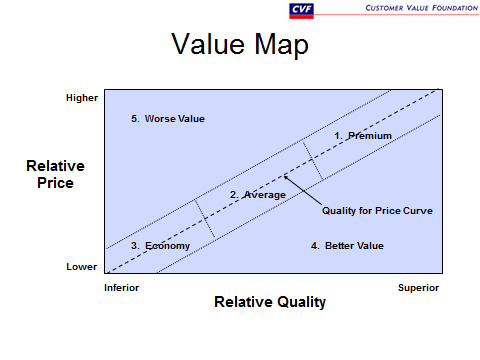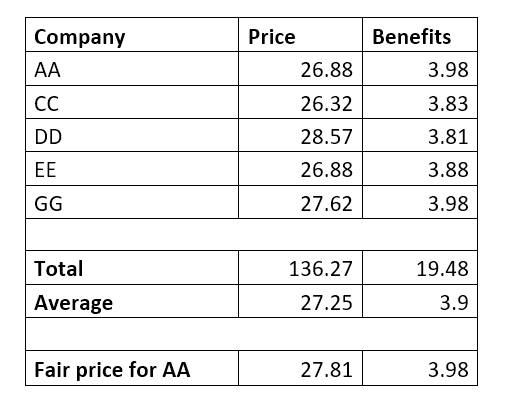If you create the value that the Customer is looking for, and if he perceives that you are creating value, what does he do? Does he choose your product first (show a preference for it) or be prepared to give you a higher price? How does it impact pricing and commoditisation?
His perception that you are creating value means he thinks you are creating a better benefits/cost ratio than competitive offers. That means he is willing to consider your product/service over competitions’. Depending on the Value you are creating, he may be willing to pay a higher price.
Let’s look at what he may be willing to pay.
We start again with the Value Map that was discussed in a previous post. The Value Map plots all competition and our company on a graph of the customer’s perception on the overall cost vs the benefits. We draw a fair value line, and then compare ourselves to competition. Those companies falling below the fair value line are adding value to customers and those above the line are depleting value.

Let us assume we are company AA. In this example, the product is a commodity. You can see we are adding value, as we fall below the fair value line. So we can increase price to reduce the value, or reduce the benefits to decrease the value. Let’s decide to increase the price to reduce the value we are giving away.

How do you know how much to add to the price to the product? There are many ways. I will show you a simple way. Let us tabulate the price versus the benefit as shown in the table below (I have taken actual prices):

You can calculate the fair value price for DD. Notice here we are looking at ratings in the graph. We could have plotted actual price also. (BB is missing in the graph. We did not plot it as we did not have enough data on it.)
You can see we are plotting the price for each of the competitors and their benefit as we found from the CVA study. The average of all the different prices is 27.25, and the average of the benefits is 3.90.
Thus an average product in this category will demand a price of 27.25. Our product gives a benefit of 3.98 and so deserves a price of 3.98 divided by 3.90 and multiplied by 27.25 giving us a price of 27.81, which is an improvement of 3.4% over AA’s current price.
Remember that in this you are in an almost commodity market, and a 3.4% improvement in price could improve your profits depending on your variable and fixed costs to almost 40 to 50%. Not bad! (How did I reach this conclusion?) Typically a 1% increase in price means a profit increase of 10-15%. Did you know this?
Let’s say your sales price is 100, your fixed costs are 25 and your variable cost is 67. Then your profit is 8. Now we increase price by 1% from 100 to 101. Our profit goes up from 8 to 9 or we increase the profit by1/8 or 12.5%)
In the real world, you might wish to increase your price by 1 to 1.5% initially, while working on improving benefits further.
Also look at AA members, with benefits of 4.10. You can figure out a fair price to charge them.In a non-commodity market, you might be able to get higher prices.
We can actually break down benefits into its attributes, and conduct this exercise for each benefit attribute and price that attribute based on the relative importance of the attribute and also the ratings from the Customers.
Pricing based on sub-attributes of Benefits
We can get even more granular. We know that benefits have sub attributes. Let’s assume these are the product, the service, and the image. I am noting down hypothetical importance or weights:
- Product 20%
- Service 45%
- Image 35%
Then we can say for the average product in the example given in the previous section, the service has 45% of a bearing on the price. So the average price of 27.25 is made up the importance of the product, the service and the image.
De-commoditisation
You will note that I said the example showed above happened to be in a commodity market — it is actually for a fertiliser. Even though the competitors keep on focusing on the quality of the fertiliser, the farmer knows there is no difference in the product. If this is the case and the fertiliser is a true commodity, farmers would buy on price. However, it turns out that the farmers prefer specific companies and their fertilisers.
It turns out that such companies have a reach out program, membership programs and contact processes that align the customer to the company. Hence, even though there might be a slight price differential, they prefer to buy the company they have an association with and trust. Such a reach out program de-commoditises the fertiliser. You can see the relative importance of the image of the product.

And which attributes to work on to increase value and potential price.

Discussion
Total Customer Value Management helps all departments and executives to have a Customer focus. It is the foundation of building a Customer culture. Customer strategy and Customer Centric Circles are building blocks of the Customer culture and a Customer mind-set. This gives the company a great competitive advantage. Do you find your executives talking about how to improve Customer Value? Have you attended such meetings?
You can see from this article that price depends on the benefits you create. If you create lower benefits, you will command a lower price and vice versa. Each part of your benefits has a price associated with it based on the relative importance of that benefit. Thus price is dependent on the value you create.
Moreover, you can decommoditise products by adding value such as a brand, image, association of the product with the customer, service etc.
Do it yourself
See if you can create a Value Map for your product, and see where you stand versus competition.
Figure out the price for the benefits you create.
How much does 1% increase of price mean for your company in profit increase?
Think of value creating ideas that can de-commoditise or add more value to your customers. Try to put them into a priority based on the importance the customer gives to these items



